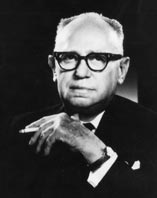What matters more: Is it what you say or how you say it?
What matters more: Is it what you say or how you say it?
Thanks to the all-but-total saturation of our culture by commercial advertising, “Advertisers know they need to have more and more advertising to get an ever narrower slice of the consumer’s attention”, says Bob Garfield [2a], Columnist of the Advertising Age. “Of course this makes us ever more resistant, requiring ever better advertising, making us ever more resistant."
60 years of co-evolution between consumers and advertisers has fundamentally transformed advertising but also other forms of visual communication. Let us begin our journey in 1948 when advertising researcher David Ogilvy [10] launched his agency dedicated to “claim” advertising, as opposed to Leo Burnett’s “image” advertising [12]. By combining modern imagery with research on advertising effectiveness, Ogilvy created powerful, original ad campaigns. But is it true that content is more important than form as Ogilvy claimed? Or is it vice-versa?

|

|
|
|---|---|---|
| David Ogilvy | Leo Burnett |
For example, David Ogilvy advocates that advertisers should focus the lion's share of their efforts on message content rather than creative execution. In his seminal work, Confessions of an Advertising Man, Ogilvy declares that what you say in advertising is more important than how you say it [10]. Ogilvy believes that successful advertising campaigns sell products by presenting consumers with a sufficient amount of factual information. While it might be tempting to assume that Ogilvy attaches no relevance to creative execution, such a conjecture would be false. In other writings, Ogilvy acknowledges that execution plays at least a minor role in advertising effectiveness. Specifically, he observed that "if the execution is inept nobody pays attention to the commercials" [11]. In its purest form “what-you-say” advertising could be likened to Google AdWords: A relevant selling message is tailored to the needs and interests of a likely buyer.
Leo Burnett, in contrast to David Ogilvy, promotes the idea that advertisers should devote the bulk of their efforts toward creative execution. Specifically, Leo Burnett recommends that advertisers identify and isolate the inherent drama associated with each product. Through a series of investigative interviews with prominent advertisers, Mayer [12] observes that Burnett has operated under the assumption that the inherent drama is often hard to find but it is always there, and once found it is the most interesting and believable of all advertising appeals. Hence, Burnett holds the position that advertising effectiveness stems from clearly presenting consumer benefits with an emphasis on how those benefits are communicated (e.g., drama advertisements, slice-of-life advertisements, and demonstration advertisements).
The question, which of the two views is more important has also divided academics alike. On the academic front, we have in Ogilvy’s camp John Philip Jones [8] who champions advertising as a form of salesmanship stressing that effective advertising says something important and meaningful about the brand in a visual way. In Burnett’s camp we have Andrew Ehrenberg [9] who sees advertising as the communicator of a brand experience: Effective advertising must be based on an understanding of the subtleties of consumers, their behavior and their hidden desires.
Case Study: 1984 (Apple Mac)
The prototypical example of such an inherent drama campaign is the launch campaign of the Apple Macintosh in 1984. For that Apple commissioned a commercial by esteemed Film Director Ridley Scott. The commercial aired during Super Bowl on January 22, 1984 showing an unnamed heroine wearing red shorts, red running shoes, and a white tank top, running through a grey, Orwellian world to throw a sledgehammer at a TV image of Big Brother — an implied representation of IBM. This was followed by an on-screen message and voiceover "On January 24th, Apple Computer will introduce Macintosh. And you'll see why 1984 won't be like '1984'.”. Apple has exploited the subliminal fear of an Orwellian society ever since, positioning itself as colorful, cool and inspiring alternative to conformity.

Apple’s current advertising campaign alludes to the 1984 campaign by anthromorphizing the differences between Macs and PCs. The campaign neither shows two computers nor does it contain any complex symbols that require decoding – just two actors filmed against a white background who impersonate PC and Mac. Or: Bill Gates and Steve Jobs.
The core message of the campaign is simplicity. Macs are hip and simple to use. In addition, Apple smartly plays the card of conformity vs. individuality and turns the negative implications of comparative advertising to its advantage. By contrasting a hip in-group vs. uncool out-group Apple creates intimacy which is at the base of its faithful community. Simplicity – in contrast to the technical complexity of the competitors – confer Apple a sense of mythical mystery, the key element for creating a community of devoted customers.
Conclusion
The two opposing views presented here boil down to the opposition of affect vs. cognition and their role in the interpretation of visuals. And as Ogilvy never drank the water he preached, we should also mix water with wine. In the interpretation of visuals, reason and emotion are distributed in the proportion of ⅓ vs. ⅔ [1]. During the last 60 years, the mentioned co-evolution between advertisers and consumers together with the advent of television shifted the balance from the cognitive textual to the affective visual.
To conclude the debate over form (Burnett) and content (Ogilvy), let us hear what Frank Luntz [2b] has to say, as his speciality is “to look for words that trigger emotion”:
“It’s not what you say [or how you say it], it’s what people hear what matters”.
As a pollster he creates and tests words which frame the public perception of issues like ‘tax relief’ [tax cuts], ‘death tax’ [estate tax] or ‘climate change’ [global warming]. So what matters most is not what you say or how you say it, it is what people perceive what you're saying!
Literature
[1] Morris, J.D., Woo, C., Geason, J. A. & Kim, J. (2002) "The Power of Affect: Predicting Intention." Journal of Advertising Research 42 (3), 7-17.
[2] Rushkoff, D. (2004) The Persuaders, Documentary in the PBS Frontline Series (November 9), http://www.pbs.org/wgbh/pages/frontline/shows/persuaders
[8] Jones, J. P. (1997) “Is Advertising still Salesmanship”, Journal of Advertising Research 37 (2), 9-15.
[9] Ehrenberg, A. S. C., Goodhardt, G. J. & Barwise, T. P. (1990) “Double jeopardy revisited”, Journal of Marketing 54(3), 82-91.
[10] Ogilvy, D. (1963) Confessions of an Advertising Man. New York : Atheneum Publishers.
[11] Ogilvy, D. & Raphaelson, J. (1982) "Research on Advertising Techniques That Work and Don't Work." Harvard Business Review 60 (4), 14-18.
[12] Mayer, M. (1958) Madison Avenue . U.S.A. New York : Pocket Books.
